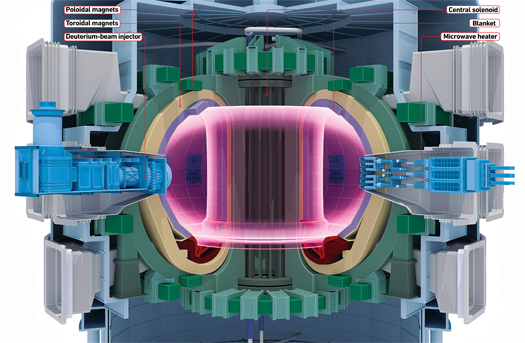

The well-publicized failures of cold fusion may have tainted the field’s reputation, but physicists have been successfully joining nuclei with hot fusion since 1932. Today, research in hot fusion could lead to a clean energy source free from the drawbacks that dog fission power plants. Fusion power plants cannot melt down; they won’t produce long-lived, highly radioactive waste; and fusion fuel cannot be easily weaponized.
At the forefront of the effort to realize fusion-based power is ITER, an international collaboration to build the world’s largest fusion reactor. At the heart of the project is a tokamak, a doughnut-shaped vessel that contains the fusion reaction. In this vessel, magnetic fields confine a plasma composed of deuterium and tritium, two isotopes of hydrogen, while particle beams, radio waves and microwaves heat it to 270 million degrees Fahrenheit, the temperature needed to sustain the fusion reaction. During the reaction, the deuterium and tritium nuclei fuse, producing helium and a neutron. In a fusion power plant, those energetic neutrons would heat a structure, called a blanket, in the tokamak and that heat would be used to turn a turbine to produce electricity.
The ITER reactor will be the largest tokamak ever made, producing 500 megawatts of power, about the same output as a coal-fired power plant. But ITER won’t generate electricity; it’s just a gigantic physics experiment, albeit one with very high potential benefits. A mere 35 thousandths of an ounce of deuterium-tritium fuel could produce energy equivalent to 2,000 gallons of heating oil. And ITER’s process is “inherently safe,” says Richard Pitts, a senior scientific officer on the project. “It can never, ever be anything like what you see in the fission world–in Chernobyl or Fukushima–and this is why it is so attractive.”
ITER’s magnets produce fields at least 1,000 times as strong as the magnets stuck to your refrigerator.To fully commercialize tokamak-based fusion, developers must overcome several challenges. First is the matter of breeding the tritium; there are only about 50 pounds of it in the world at any given time because it is not naturally occurring and decays quickly. (Deuterium is not radioactive and can be distilled from water.) Although ITER may use tritium produced by nuclear power plants, a full-scale fusion plant will need to produce its own supply–neutrons from the fusion reaction could be used to convert a stash of lithium into tritium. In addition, physicists must also determine which materials can best withstand the by-products of the fusion reaction, which will wear down the tokamak’s walls. Finally, residual radioactivity in the device will pose maintenance problems because people won’t be able to work safely within the vessel. ITER scientists must develop robots capable of replacing parts that can weigh up to 10 tons.
ITER will begin experiments in 2019 in France. If those are successful, the data produced by the project will aid the ITER team in the design of DEMO, a proposed 2,000- to 4,000-megawatt demonstration fusion power plant that will be built by 2040.
_(Click the above image for more information.)
Fuel
Engineers inject two hydrogen isotopes, deuterium and tritium, into the tokamak, a high-powered doughnut-shaped vacuum chamber.
Plasma
A strong electric current heats the deuterium and tritium gases and ionizes them, forming a ring of plasma, a glowing soup of charged particles.
Heat
Radio waves, microwaves and high-energy deuterium particle beams heat the plasma. At high temperatures, the deuterium and tritium fuse to form a helium atom and a neutron.
Containment
If the plasma touches the walls of the tokamak, it will scuttle the fusion reaction. The charged particle is confined in a magnetic field made from 39 superconducting poloidal, toroidal and central solenoid magnets positioned around the outside of the doughnut and within its hole.
Lining
The vessel is lined with a steel blanket 1.5 feet thick to protect the tokamak walls from highly energetic neutrons.
